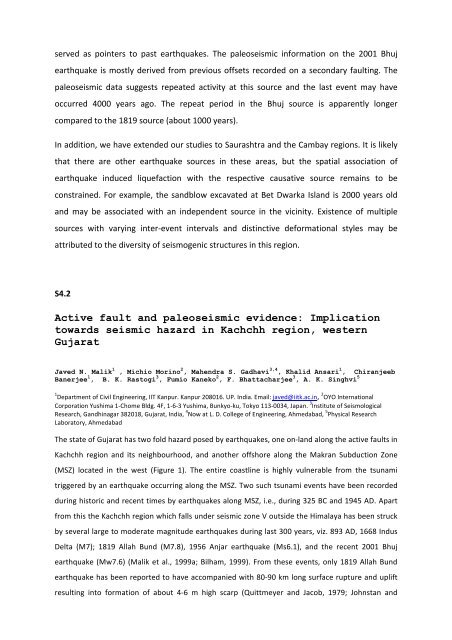indo–us workshop on “intraplate seismicity†- The CERI Blog
indo–us workshop on “intraplate seismicity†- The CERI Blog
indo–us workshop on “intraplate seismicity†- The CERI Blog
You also want an ePaper? Increase the reach of your titles
YUMPU automatically turns print PDFs into web optimized ePapers that Google loves.
served as pointers to past earthquakes. <strong>The</strong> paleoseismic informati<strong>on</strong> <strong>on</strong> the 2001 Bhuj<br />
earthquake is mostly derived from previous offsets recorded <strong>on</strong> a sec<strong>on</strong>dary faulting. <strong>The</strong><br />
paleoseismic data suggests repeated activity at this source and the last event may have<br />
occurred 4000 years ago. <strong>The</strong> repeat period in the Bhuj source is apparently l<strong>on</strong>ger<br />
compared to the 1819 source (about 1000 years).<br />
In additi<strong>on</strong>, we have extended our studies to Saurashtra and the Cambay regi<strong>on</strong>s. It is likely<br />
that there are other earthquake sources in these areas, but the spatial associati<strong>on</strong> of<br />
earthquake induced liquefacti<strong>on</strong> with the respective causative source remains to be<br />
c<strong>on</strong>strained. For example, the sandblow excavated at Bet Dwarka Island is 2000 years old<br />
and may be associated with an independent source in the vicinity. Existence of multiple<br />
sources with varying inter-‐event intervals and distinctive deformati<strong>on</strong>al styles may be<br />
attributed to the diversity of seismogenic structures in this regi<strong>on</strong>.<br />
S4.2<br />
Active fault and paleoseismic evidence: Implicati<strong>on</strong><br />
towards seismic hazard in Kachchh regi<strong>on</strong>, western<br />
Gujarat<br />
Javed N. Malik 1 , Michio Morino 2 , Mahendra S. Gadhavi 3,4 , Khalid Ansari 1 , Chiranjeeb<br />
Banerjee 1 , B. K. Rastogi 3 , Fumio Kaneko 2 , F. Bhattacharjee 3 , A. K. Singhvi 5<br />
1 Department of Civil Engineering, IIT Kanpur. Kanpur 208016. UP. India. Email: javed@iitk.ac.in, 2 OYO Internati<strong>on</strong>al<br />
Corporati<strong>on</strong> Yushima 1-‐Chome Bldg. 4F, 1-‐6-‐3 Yushima, Bunkyo-‐ku, Tokyo 113-‐0034, Japan. 3 Institute of Seismological<br />
Research, Gandhinagar 382018, Gujarat, India, 4 Now at L. D. College of Engineering, Ahmedabad, 5 Physical Research<br />
Laboratory, Ahmedabad<br />
<strong>The</strong> state of Gujarat has two fold hazard posed by earthquakes, <strong>on</strong>e <strong>on</strong>-‐land al<strong>on</strong>g the active faults in<br />
Kachchh regi<strong>on</strong> and its neighbourhood, and another offshore al<strong>on</strong>g the Makran Subducti<strong>on</strong> Z<strong>on</strong>e<br />
(MSZ) located in the west (Figure 1). <strong>The</strong> entire coastline is highly vulnerable from the tsunami<br />
triggered by an earthquake occurring al<strong>on</strong>g the MSZ. Two such tsunami events have been recorded<br />
during historic and recent times by earthquakes al<strong>on</strong>g MSZ, i.e., during 325 BC and 1945 AD. Apart<br />
from this the Kachchh regi<strong>on</strong> which falls under seismic z<strong>on</strong>e V outside the Himalaya has been struck<br />
by several large to moderate magnitude earthquakes during last 300 years, viz. 893 AD, 1668 Indus<br />
Delta (M7); 1819 Allah Bund (M7.8), 1956 Anjar earthquake (Ms6.1), and the recent 2001 Bhuj<br />
earthquake (Mw7.6) (Malik et al., 1999a; Bilham, 1999). From these events, <strong>on</strong>ly 1819 Allah Bund<br />
earthquake has been reported to have accompanied with 80-‐90 km l<strong>on</strong>g surface rupture and uplift<br />
resulting into formati<strong>on</strong> of about 4-‐6 m high scarp (Quittmeyer and Jacob, 1979; Johnstan and


